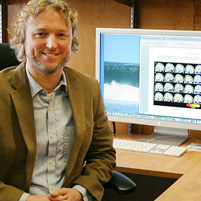Distraction: A Good Thing

David Creswell
When faced with a difficult decision, it is often suggested to "sleep on it" or take a break from thinking about the decision in order to gain clarity.
But new brain imaging research from Carnegie Mellon University finds that the brain regions responsible for making decisions continue to be active even when the conscious brain is distracted with a different task.
Published in the journal "Social Cognitive and Affective Neuroscience," the research finds that the brain regions responsible for making decisions continue to be active even when the conscious brain is distracted with a different task.
"This study provides some of the first clues for how our brains process this information for effective problem-solving and decision-making," said J. David Creswell, assistant professor of psychology in CMU's Dietrich College of Humanities and Social Sciences and director of the Health and Human Performance Laboratory. "What's most intriguing is that participants did not have any awareness that their brains were still working on the decision problem while they were engaged in an unrelated task."
For the study, Creswell along with alumnus James K. Bursley (DC'12) and Northeastern University's Ajay B. Satpute presented 27 healthy adults with information about cars and other items while undergoing neuroimaging.
Then, before being asked to make decisions about the items, the participants had to complete a difficult distractor task — memorizing sequences of numbers — to prevent them from consciously thinking about the decision information.
The team confirmed previous research demonstrating that a brief period of distraction — in this case two minutes — produced higher quality decisions about the cars and other items.
But did this effect occur because the distraction period provided an opportunity for the brain to take a break from decision-making and then return to the problem with a fresh look? Or does the brain continue to unconsciously process decision information during this distraction period?
The research supports the latter explanation. When the participants were initially learning information about the cars and other items, the neuroimaging results showed activation in the visual and prefrontal cortices. These regions of the brain are known to be responsible for learning and decision-making.
And during the distractor task, both the visual and prefrontal cortices continued to be active — or reactivated — even though the brain was consciously focused on number memorization.
The results also showed that the amount of reactivation within the visual and prefrontal cortices during the distractor task predicted the degree to which participants made better decisions, such as picking the best car in the set.
CMU's Department of Psychology has helped to establish Carnegie Mellon as a world leader in brain sciences. The university recently launched a Brain, Mind and Learning initiative to build from its research excellence in psychology, computer science and computation to continue to solve real-world problems.
Bursley received a Rothberg Research Award in Human Brain Imaging which supported this study. The award was made possible by a gift from CMU alumnus and trustee Jonathan M. Rothberg (E'85), founder of four genetics companies aimed at improving human health.
Related Links: Dietrich College of Humanities & Social Sciences | Brain, Mind & Learning | Health & Human Performance Lab
